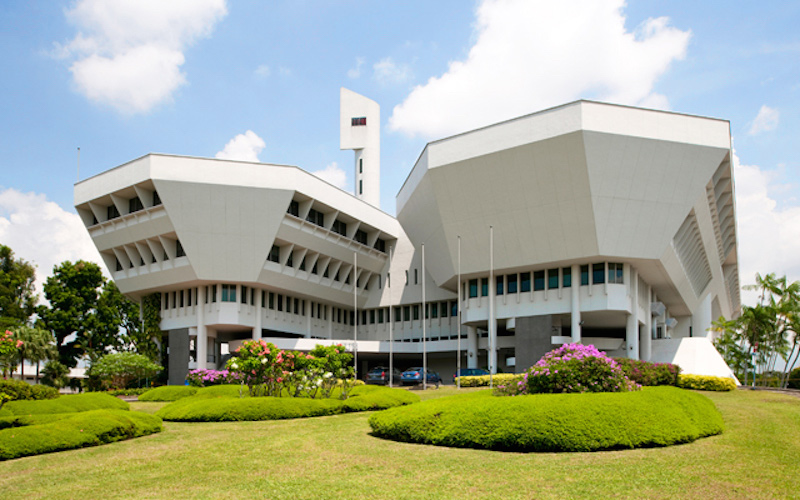Lim Chong Keat, MArch ’57, has created a towering legacy in Southeast Asia, in more ways than one. He’s responsible for modernist landmarks such as the Komtar Tower in Penang (once Malaysia’s tallest skyscraper) and the Singapore Conference Hall—which for half a century has hosted cultural and political events, serving as home to the Singapore Symphony Orchestra and later to the Singapore Chinese Orchestra. His design for Jurong Town Hall, which now houses Singapore’s Trade Association Hub, is angular and sleek, a fitting design for a key engine of the country’s modern economy.
The Conference Hall and Town Hall, completed in 1965 and 1974, respectively, are among the first modern buildings to be designated by the Singapore Heritage Board as national monuments. For Lim, 91, this is particularly gratifying because “these projects were major civic buildings won by open architectural competition,” he notes. In fact, his firm won the Conference Hall contract through the first such competition of its kind held since Japanese occupation of the country ended in the mid-1940s.

Born in the Malaysian state of Penang, Lim has served on the UN Review Panel for the State and City Planning project for Singapore, the Singapore Housing and Development Board, and the Malaysian Forestry Research and Development Board. President of the Singapore Institute of Architects, he received its highest honor, the Gold Medal, and the corresponding honor from its Malaysian counterpart.
For many years, Lim’s brother, Lim Chong Eu, served as chief minister of Penang. While detractors implied that the Komtar contract was awarded thanks to family connections, Lim says they were unaware of his firm’s professional record—which by then already included some of the tallest buildings in Singapore—and his training in urban design at MIT. “We were one of the very few firms in the country qualified to do urban design,” he says. The Komtar complex was the result of extensive urban studies that Lim did in collaboration with other consultants on how to revitalize the central area of his hometown. Lim also involved his friend and colleague Buckminster Fuller in designing the project’s geodesic dome.
Lim arrived at MIT in 1956 on a prestigious Harkness (then Commonwealth Fund) Fellowship, fresh from the University of Manchester in the United Kingdom. He was drawn to the States by the modernist movement led by Walter Gropius and Frank Lloyd Wright.
“In 1936, when I was young, I was motivated by a photograph of Wright’s famous building Fallingwater, and that’s what compelled me toward architecture,” he says. “The chance to go to the States under this very well-endowed fellowship enabled me to travel all over, and I actually met Frank Lloyd Wright and interviewed him in 1957. This was the dream period of the USA. I could knock on doors and usually be invited in. People then were so hospitable.”
As a grad student at MIT, Lim was drawn to architectural acoustics, studying under professor Robert Newman, MArch ’49, who became a treasured friend (and later consulted on the Singapore Conference Hall). The young student traveled frequently to New York City to attend performances at the Metropolitan Opera House and Carnegie Hall, enthralled by the music and acoustical ambience. Lim also cites visual artist and MIT professor György Kepes as an inspiration.
After MIT, Lim returned home to mentor new generations of architects, teaching at Singapore Polytechnic and lecturing around the world. He hopes that architectural students today receive the kind of comprehensive training he did so they understand the holistic nature of architecture.
“Urbanization has gone wrong, and you really have sociological problems—wealth inequality. Both things got out of control. A well-planned town will create a conducive, harmonious society,” he says. “Sadly, localized, dedicated expertise in planning and development control has become almost extinct in the face of commercial opportunism.”
In recent years, Lim has pursued a different kind of harmony through botany, recalling childhood days in his father’s garden. He maintains a private botanical garden in Penang with the area’s largest collection of Malaysian palms and gingers. He’s now compiling four volumes of his taxonomic research on more than 70 species, previously published in Folia malaysiana, a journal he launched in 2000.
As national landmarks, his signature structures have strong roots, too. “In retrospect, I feel glad the buildings represented what I tried to design in a comprehensive, original way,” he says. “But I try not to be immodest!”
from MIT Technology Review https://ift.tt/3jrXMK1
via IFTTT
Comments
Post a Comment